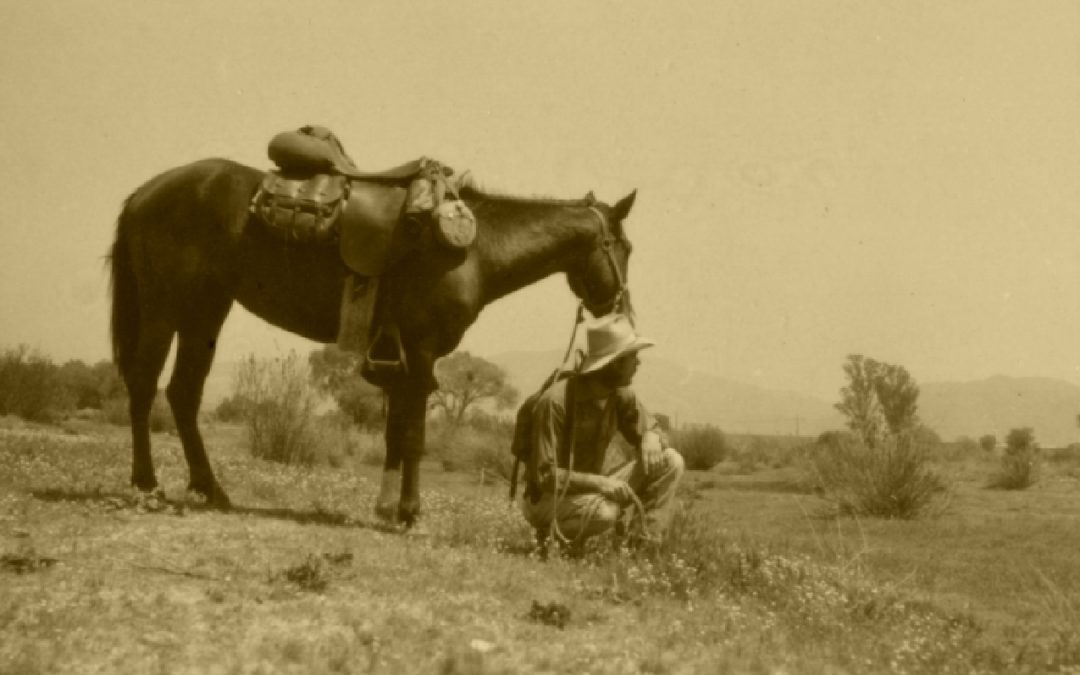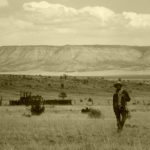I come awake after a restless night’s sleep in the foothills of the mountains of northern Arizona. Out of habit, I reach to find my single action Colt that lies next to me inside my sleeping bag. My thumb instinctively checks to see that the hammer hasn’t been accidently pulled back. Then I slide the pistol gently up and out into the morning air, where I check to see that the hammer still rests on an empty chamber. I reach over and slide the Colt into its holster, which lies draped over the saddle next to my head. Finally, I drag myself to a sitting position, my upper body now exposed to the cool morning breeze.
Gizmo sees me stirring and immediately issues his early morning whinny to let me know that, yes, he is still there and ready to face the day.
“Good morning, pal,” I say and climb out of my bedroll.
It’s a three-pound down sleeping bag, lightweight yet sufficient to keep me warm in temperatures well below freezing, or so they claim. It has done its job well, and I’ve suffered no discomfort from the chilly night air here in the mountains. In fact, it was warm enough last night to take my pants and socks off, and I retrieve them now from inside the sleeping bag. I don’t like having to step into cold pants in the morning, so I usually store them with me inside my bedroll.
I pull myself out of the bag, stretching a bit and trying to shake off the sore back and stiff limbs of a hard night’s sleep on the ground. My bedroll has drifted off the ground cloth I had laid out beneath it, so there is some dirt to be wiped off. The ground cloth is just my rain slicker doing double duty. I can lay it flat out and put the sleeping bag on top of it. It’s not exactly a padded mattress, but it does serve to keep the morning moisture away, and I like to think that it discourages rattlesnakes and other critters from crawling into bed with me during the night. So far, the only evidence of this is that they haven’t done so.
I extract myself from the sleeping bag and slowly get up. Gizmo whinnies again when he sees me stand and walk away from camp to find a place to pee. Upon returning, I check my boots for scorpions, snakes, spiders, or other critters. Finding none, I pull on my socks and boots. I have no mirror, so I run a comb through my dirty hair by feel. I pull my toothbrush from the saddlebags and pour a bit of water on it from the canteen. I have cut the handle off the toothbrush to lighten the load, so I have to hold it between my fingers and reach into my mouth to brush. I have no toothpaste (again, to lighten the load). I simply brush with cold water. It’s better than nothing.
If we were staying over, I would make a fire and boil some water for coffee or sweet grass tea, but since we’re continuing our travels today, I won’t do that. I like to do most of our riding in the early hours of the day and usually dispense with coffee and breakfast in the morning to hit the trail.
To pack up camp, I shake out the sleeping bag then push it down into its small cotton stuff bag. I slide the paperback novel I was reading the night before into one of the saddlebags. When that gear is stowed, I pull my knife out of its small scabbard attached to my gun belt. It is an old Case folding knife. It has a single blade that folds open on one end and a marlinspike, or fid, that folds open on the other. It’s handy because I can open cans with the blade and use the fid as a hoof-pick. I grab the brush for Gizmo.
I walk over to him and give him a pat to say good morning. I look him over to make sure he hasn’t cut himself on anything sharp during the night. I pick up his feet one by one, examine each hoof, and run the knife’s fid between the sole and frog to clear any rocks or pebbles lodged there. I check the condition of the shoes and make sure the nails that hold them are still tight.
I brush him down, starting with his face (which he loves) and moving down each side of him in turn. I scratch each ear and spend some time running my thumb inside them to eliminate any deer flies, bugs, or crud that may be lodged in them. I wipe away any snot or grime that has collected in his nostrils and lick my finger to wipe away the sleep from his eyes. I look for cinch galls and saddle sores or any other marks or scratches he may have. If he’d had any, I would doctor them with whatever appropriate medicines were on hand. This might include spraying them with Furox, dobbing them with purple Gentian Violet, applying Bickmore’s gall salve, or using congealed bacon grease from a small jar kept in a saddlebag. This morning Gizmo is fine, so I don’t need to doctor him.
Satisfied that my horse is clean and ready for the day, I turn to put my gear in order. I gather anything left lying around from the night before and clean up the camp so that I leave no trace. I pick up eating utensils, my logbook and other writing material, socks and shirts left out to dry. These are packed in my small day pack or in the saddlebags and, after taking a last look around, I am ready to saddle up.
I shake out the orthopedic saddle pad, making sure no dirt is on it. I use it as my mattress, or as a half-mattress, by putting it under my upper body during the night. It helps to soften the hard ground and to mediate the rocks and bumps I come into contact with. Then I drag my saddle and pads over to Gizmo. I throw the ortho pad onto his back, straighten it, and lay a piece of foam rubber across his withers. This will keep the saddle up off them so he isn’t pinched or rubbed. I swing the saddle across his back and adjust it, the pommel over his withers and saddle bars resting in place along his back. The girth has an orthopedic sleeve to prevent cinch galls. I wipe it to make sure it’s free of dirt, thorns, and other foreign objects. I run the latigo strap through the cinch ring and pull it up so that it’s snug, but not overly tight, before I tie it off using the over-under-sideways method of tying a normal western latigo knot. I leave the billet end of the latigo hanging down.
The saddle is a German caisson type, made in Czechoslovakia during World War II. It was used with teams of horses to pull cannons. They didn’t use a driver, as with a normal wagon or carriage, but instead the horses were ridden. The saddle has a raised seat slung between the pommel and the cantle that sits high above Gizmo’s back and allows airflow. It is an English style saddle, with free swinging English style stirrup leathers. I modified the English girth system, by replacing the buckles with western style latigo straps for more adjustment options. I use a breast collar to keep it from sliding back, and a britchen to keep it from sliding forward on Gizmo. I have modified it by adding rings, footman loops, and other fittings that allow me to attach various gear, like saddlebags, bedroll, rain slicker, canteen, and picket rope, easily and securely. I have added a western saddle horn to it. It isn’t strong enough to rope cattle with, but it’s handy for hanging my canteen and other odds and ends from time to time.
Once the saddle is cinched, I reach around to the off side (right) and catch the breast collar, which has been looped over the saddle horn for the night. I pull it beneath Gizmo’s neck and across his chest and buckle it to a ring on the near side (left) of the saddle. It is a small collar, narrow—not wide like those on western roping saddles—and hangs loosely across his chest, like the ones on English saddles. It is not fastened between his legs to the cinch, but instead rides freely. It forms a V with a ring in the middle, so that it rides above his shoulders on either side. It is meant to keep the saddle from slipping back but allows Gizmo free movement of his neck and shoulders.
With the girth and breast collar attached, I fasten the britchen. This is a strap attached to the back of the saddle on each side that goes under the horse’s tail and across his hips. A britchen strap is used mostly on a packsaddle to keep it from sliding forward. Gizmo doesn’t mind it under his tail and has never made any fuss about it, not even the first time I put it on him.
All this time Gizmo stands quietly, still staked by his front foot and free to walk around if he wishes. He knows the drill, so he stands patiently while I tend to the morning chores. I throw the McClellan saddle bags on behind the saddle and buckle them with two short straps that slide through brass footman loops. A long strap on the lower front of each bag attaches it to the girth and keeps the bags from flopping up and down when Gizmo trots. This is the same way that these US Cavalry bags are fastened to a McClellan saddle. I buckle the bedroll on top of them using a pair of one-inch leather straps that are fixed to the saddle. These have sliding spring buckles on them, making it easy to cinch the bedroll down quickly without having to tie anything. Regular saddle strings will come loose, causing things to fall on the trail during the day. These buckle straps pull down tight and never get loose.
I fold and roll my rain slicker and drape it over the pommel of the saddle, where there are two more straps. These are smaller than the two holding the bedroll, but they have the same sort of sliding buckles on them and are perfect for attaching the slicker to the front of the saddle. There is also a small brass ring that I can clip the canteen to, on the off side of the pommel. Once these are in place I grab the long nylon rope I use for reins and clip each end to the cheek pieces in Gizmo’s halter. I remove the hobble on his front foot and roll it up with the thirty-foot picket rope, then clip this to the near side of the pommel. I sling my canteen over the saddle horn and we’re ready to head out. The last thing I do is a dummy check—a final glance around the camp to see that I have everything—before I step into the saddle and turn Gizmo toward the east.


